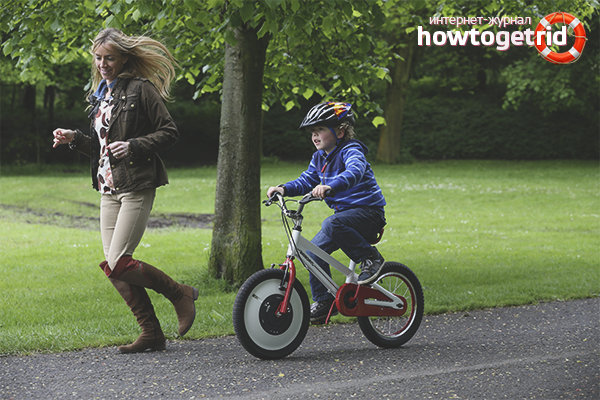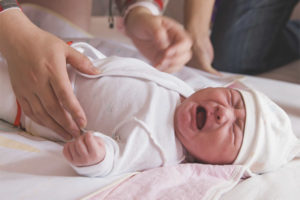The content of the article
Kids like tricycles. They are fast, comfortable and equipped with a loud beep that scares pigeons and passersby. But the child grows up and changes the children's bike for an adult who has only two wheels. How to help the young owner to master the new transport? First, the baby is taught to keep balance and control the steering wheel. They show how to pedal and properly brake. And then let you experiment and have fun.
Equipment and comfortable steering wheel
Training begins with the purchase of the right bike, which corresponds to the age and height of the child. Parents go to the store together with the baby and “try on” the vehicle they like:
- Supporting the mini-bike, seat the young driver on the seat.
- A good bike has a steering wheel on the level of a child’s chest.
- The leg of the child, resting on the lower pedal, is straight, but he does not have to stand on a sock to get it.
- The seat is comfortable, nothing interferes and does not press.
A bicycle bought for growth will be standing in a garage or a hallway, dropping in dust. It is difficult for a child to drive a massive iron bike, which is heavier and taller by two or three times.
It is recommended to start with bicycles with rear brakes. It is easier for the child to turn the pedals in the opposite direction to stop, than to constantly keep your finger on the button located on the steering wheel and try not to press it accidentally.
For kids up to 4–6 years, tricycles or variants with additional small supports are more suitable. Schoolchildren buy an ordinary bicycle without a frame, to make it easier to throw a leg.
Together with the vehicle, they get knee-pads with elbow pads, a strong helmet and comfortable closed shoes. Falls are inevitable, but the more securely the baby is protected, the less injuries it will receive.
Before training, the child puts on pants and a jacket with long sleeves. It is better to choose old things that are not sorry to break and throw away. No sandals, slippers or uncomfortable shoes.The perfect shoe is sneakers with a thick sole. They do not rub and protect the toes from abrasions.
Emotional attitude
It’s scary for a child to drive a two-wheeled vehicle, because the bike constantly rolls left and right, and the baby may fall. To force a daughter or son is impossible. Learning from the blues discourages desire and rarely gives positive results.
Young driver acquainted with the new transport. Go out with him for a walk and offer to roll next to him or ride a bike, like a scooter. The kid can put one foot on the pedal, and the second to push off from the asphalt. The child will have fun and relax, get used to the two-wheeled bike and stop being afraid of him.
Then the parent suggests climbing on the seat, putting both feet on the pedals. Holding the bike behind the wheel and trunk, he slowly tilts it in different directions. Let the kid try to level the bike or put his foot on the ground so as not to fall. The main thing is not to swing it much, so as not to miss.
Bike is turned into a fun ride, and learning is a game. If one of the parents knows how to skate, he is recommended to ride the children's transport and make a small circle to show that there is nothing terrible.
You need to train in places where there are few people and pets. A kid who has moved a cat or a bird will refuse a bicycle for a long time, if not forever. The road should be smooth, without pits and sharp slopes, after all, a small depression or pebble is enough for the young cyclist to lose balance.
Parents are advised to bring along a mini first-aid kit with cotton wool, a plaster and an antiseptic in order to process scratches and wounds. During training, it is important to remain calm and not scream at the child, because he is just learning. You can not show excitement, because the baby because of his mother's or father's fears and constant prompts and withdrawal becomes uncertain and distracted.
Stage 1: Short distances and braking
Children who have mastered a tricycle at an early age are easier to train. They know how to pedal and turn, get tired more slowly. The child, who first learned about the existence of two-wheeled transport, will have to learn from scratch. First, he gets used to the steering wheel, so for a while the bike is turned into a scooter. How?
The pedals are removed from the bike, because they only interfere and distract the attention of the young driver. The seat is lowered so that the baby can reach up to the ground or curb.Sitting on an improvised scooter, a child learns to keep balance.
He should push off from asphalt and press his lower limbs, trying to balance and firmly squeeze the steering wheel. If the vehicle suddenly begins to fall to the side, the baby stops and quickly rests its feet on the ground.
Important: Some children prefer to jump off a bent bike. Before training, the kid is told that he needs to keep his balance and not let go of the steering wheel, otherwise he will not be able to overcome fear.
A child who has learned to overcome short distances is shown how to brake. They put the pedals back in place and offer to push off from the ground, and stop the bike at a signal without touching the asphalt with their feet.
If the child is difficult to concentrate on two tasks at the same time, dad comes to the rescue:
- The parent grabs the seat with one or both hands and pushes the vehicle along with the young driver.
- The kid puts his feet on the pedals, but does not twist them. It only drives the steering wheel and balances so that the iron horse does not fall.
- Dad should move fast, preferably run.Having reached 50–100 meters, an adult gives a “Stop” signal, removing his palm.
- The kid turns the pedals and smoothly slows down, and when the bike completely stops, he lowers his feet on the asphalt.
Dad or mom runs alongside the vehicle in order to catch the child if he loses his balance. Children who are not insured are more likely to panic and bump into or fall into something.
Stage 2: Balance
The young cyclist, who knows how to brake, is taught to push off and gain speed, and also to jump on the seat in time and to keep balance. First, the child does not work. The vehicle is falling, should the child throw his leg or turn the steering wheel unsuccessfully, therefore an adult should be near him.
Running behind the bike, bent in half, is not very convenient. There is a high chance of pulling your back or spraining your leg. Modern parents use a pusher handle to hold the bike.
Economical and quick-witted adults prefer a normal jump rope. Wrap sports equipment around the saddle, and when the transport begins to fall, pull the leash and return it to the upright position.
Important: You can not grab the shoulders or the steering wheel, preventing the child to control the bike, otherwise he will never learn to keep balance.
Children before training say that you can not tilt the body to the side. Hands need to rest on the steering wheel, so that the bicycle, hitting the stone, suddenly did not climb on the rear wheel and did not drop the passenger. The cyclist must learn these rules, and then proceed to practical exercises:
- The kid accelerates independently and jumps on his bike, starts to pedal.
- Daddy or mom runs alongside, but when the child picks up speed and fully concentrates on the road, lets go of the trunk and allows the young driver to ride without help.
- If a cyclist starts to panic, they calm him down and then offer to slow down.
- Parents should praise the baby, because he ran a two-wheeled vehicle without help. This will encourage the child and increase his self-esteem.
When a young driver learns to overcome long distances without falling, he is shown how to properly turn. It is advisable to train on a wide road or next to a flowerbed, around which you can cut circles.
Stage 3: Security
For the first 2-3 months, children ride a bike only under the supervision of their parents. If a mom or dad decides that the baby is old enough, then they will have a preventive conversation with him, telling the rules of the road for two-wheeler owners:
- It is forbidden to go on the road intended for cars. Only cyclists with great experience know how to slow down in time or turn off to the side, avoiding an accident.
- The road to go on a zebra, an iron horse roll alongside.
Children are told that it is impossible to check puddles and move down from too high slides, if you are not confident in your own abilities. Driving a bike at high speed is difficult, you can lose your balance and fall, injuring your arm or neck.
The kid, who conquered the iron horse, satisfied with the test. They offer to ride in the park on crowded paths, carefully circling walking visitors. If the child has coped with the task, you need to check how fast his reaction.
Dad hides behind a tree, and when a cyclist passes by, suddenly jumps out and blocks the way.The baby must brake or collapse in time, while maintaining balance and not falling. The main thing is that in an emergency an adult should have time to grab the bike and return it to the vertical position. A child who has successfully passed all the exams can be let go with friends and not worry, because he has become a real professional.
Riding a two-wheeled bike is fun and useful. Children quickly master the bike, but if the baby does not work, it is recommended to wait. It is impossible to put pressure on the baby, it is better to introduce him to a scooter or ranbike. After such vehicles it will be easier for the child to keep balance and not to fall.
Video: how to teach a child to ride a bike












To send